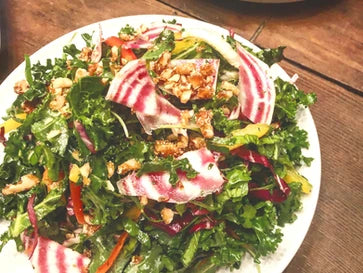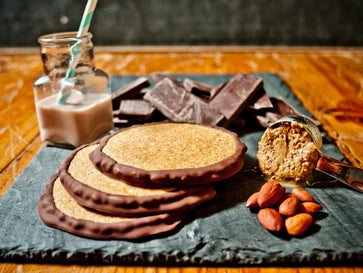It’s wild to see fruits, vegetables, and grains gain celebrity status among grocery stores, farmer’s markets, and menus at restaurants. To see a shift in the food world based on what is popular at the moment can be a really great thing if that food is health forward. American’s ideas and beliefs on what is considered healthy have changed and continue to change over time. Health food trends go way back. So, we are obviously going to touch on the big ones here, avocado, kale, etc., but let’s take a look back to the turn of the century to see how these trends come about.
In 1912, foods that had been known to have vitamins started to become popular. As vitamins were brand new at this time, people started to realize that you could be getting these same benefits through food. Foods such as fruits, vegetables, and milk were known to be rich in nutrients. Nutrition became a political issue with the connection to World War I. Food rationing, combined with vitamins B1, B2, C, and D were used as disease prevention and cures during the war. The 1920s brought on The Inuit Diet, which is similar to what we know now as Keto. It consisted of low-carb, and high-fat meals. Canned tuna became incredibly popular in the U.S. in part, due to this diet. Food processing began during this decade starting a 100+-year-old tradition. Sliced manufactured white bread got its start during this time even though some people advocated for wheat options as if it was more nutrient and fiber-dense.
Some great food options such as seaweed, grapefruit, and bananas became popularized in the 1930s. Unfortunately, this came about because of the strict diets of the time. As science led to the idea of the calorie, it quickly came into the food world. Calories were said to be understood in the 19th century, however, became more known to the public through diets in the ’20s-’30s. One of the first diet drinks to hit stores was made with seaweed and called Dr. Stoll’s Diet Aid. Bananas became part of an anti-diabetes diet when mixed with milk, and the very restrictive Grapefruit Diet used for weight loss is seen and will repeat throughout history again and again. In the 1940s, more plant-based options started to arrive. Because the necessity of using one’s garden was prevalent during this time, a lower-fat diet, heavy in fruits, vegetables, and grains was embraced, and less in meat and dairy. Apple cider vinegar, cayenne pepper, and lemon were popularized during these years as well. Any takers on what these ingredients were used for? The Master Cleanse, of course.
Post World War II brought more and more packaged foods, processed foods, and meat, as well as the standard American breakfast of bacon and eggs. This was in part because of the excess meat that had accrued. The 1950s brought the Cabbage Soup Diet, and Weight Watchers was introduced in the ’60s along with the “Drinking Man’s Diet.” This scary diet allowed for one to incorporate alcohol into most meals, and eat a low carb, high-fat diet which included heavy steak consumption. This was also the era of the Atkins Diet. Red meat rolled over in the ’70s and the much-loved granola made an appearance. The organic food wave and granola was a West coast trend and a wonderful non-processed alternative to store-bought cereals and snacks. Salad bars also gained momentum at this time. The ’80s brought The Pineapple Diet as well as frozen meals such as Lean Cuisine. In the ’90s, Slimfast became a popular diet trend and meal replacement. As the fat-free phenomenon started, Nabisco also introduced Snackwells, a fat-free line of cookies and crackers. This lengthy list brings us to where we are today.
Kale

When did kale become cool? Between 2007 and 2012, the farm production of kale rose 60% according to the U.S. Department of Agriculture. Another great survey from 2013-2014 showed that the word “kale” increased on restaurant menus by 47%. We fully stand behind this food trend as kale is a nutrient-dense, and versatile vegetable packed with fiber, calcium, protein, and A, C, and K vitamins. But did you know that there is a PR team behind this leafy green? Yes, the American Kale Association hired the NY PR firm, My Young Auntie to help push this cruciferous starlet onto the people. The firm even created kale merchandise that gives back to the Edible Schoolyard Project (an initiative that teaches kids to garden). In 2011, Gwyneth Paltrow was featured on “Ellen” making kale chips. In 2012, kale made Time Magazine’s “Top Ten Food Trends list.” Kale was seen in smoothies, on university-esque sweatshirts and t-shirts, salads, and more. The rest is history.
Cauliflower
Cauliflower, another cruciferous vegetable, rose to fame in the past decade. Cauliflower is so versatile and a great option for plant-based meals. When they are in season, you can even find an array of colors including purple, green, and orange, depending on where you live. You can find cauliflower in buffalo “wings,” pizza crust, “steaks,” and “rice” across restaurants, bars, and pizzerias everywhere.
Avocado
Avocados are beyond trendy and we don’t think they are going anywhere! Also, popularized heavily in the last decade, avocados went from being used for primarily everyone’s favorite, guacamole, and onto, yep – you guessed it, avocado toast. This super easy breakfast option is pretty much just a slice of toast with guacamole smashed onto the top of it and seasoned with salt, pepper, crushed red pepper, or anything else you can think of! Some other fun options for toppings are za’atar - the Middle Eastern herb mixture, sliced tomatoes, olives, or sprouts.

Some other food trends we’ve seen out there have been Brussel sprouts, seen a lot as appetizer or side dishes, tossed in sauces such as tamari, a sweetener like maple syrup, and balsamic vinegar. Celery also started flying off the shelves when celery juice became all the rage a couple of years back. It really only takes one beverage, dish, or diet to add a food item to the trending list.
P.S. & Co. Meal Plans
Right now you may see some of our favorite healthy food trends across our new meal plans! Find options on our sample menu such as:
Organic Breakfast Tofu Scramble: Served with black bean sofrito, pico de gallo, and guacamole
Organic Caesar Salad: Kale, bbq tempeh, pickled onions, and homemade Caesar dressing
Organic Cold-Pressed Green Special Juice
Organic Summer Herb Salad: Avocado, caramelized onions, lentils, & lemon thyme vinaigrette
Avocado Toast: house-made country whole-grain bread, pickled vegetables, and our own “everything bagel” blend



We can provide 7 Days worth of organic/plant-based/gluten-free breakfast, lunches, and dinners to help you reset and restart! This plan is perfect for those new to eating organic, vegan, gluten-free, and healthy.
https://www.ranker.com/list/healthy-food-trends-over-the-years/melissa-sartore?page=3





Leave a comment
This site is protected by hCaptcha and the hCaptcha Privacy Policy and Terms of Service apply.